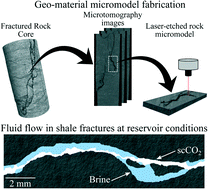Geo-material microfluidics at reservoir conditions for subsurface energy resource applications
Abstract
Microfluidic investigations of flow and transport in porous and fractured media have the potential to play a significant role in the development of future subsurface energy resource technologies. However, the majority of experimental systems to date are limited in applicability due to operating conditions and/or the use of engineered material micromodels. We have developed a high pressure and temperature microfluidic experimental system that allows for direct observations of flow and transport within geo-material micromodels (e.g. rock, cement) at reservoir conditions. In this manuscript, we describe the experimental system, including our novel micromodel fabrication method that works in both geo- and engineered materials and utilizes 3-D tomography images of real fractures as micromodel templates to better represent the pore space and fracture geometries expected in subsurface formations. We present experimental results that highlight the advantages of using real-rock micromodels and discuss potential areas of research that could benefit from geo-material microfluidic investigations. The experiments include fracture–matrix interaction in which water imbibes into the shale rock matrix from etched fractures, supercritical CO2 (scCO2) displacing brine in idealized and realistic fracture patterns, and three-phase flow involving scCO2–brine–oil.


 Please wait while we load your content...
Please wait while we load your content...